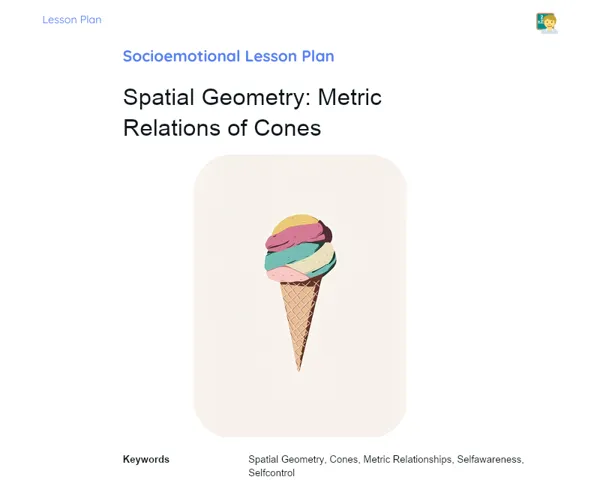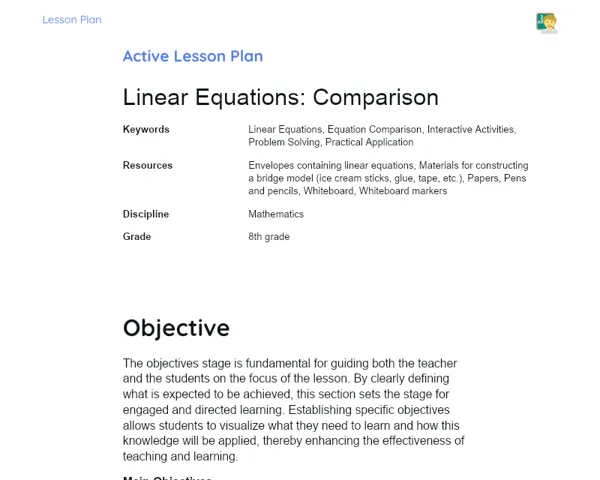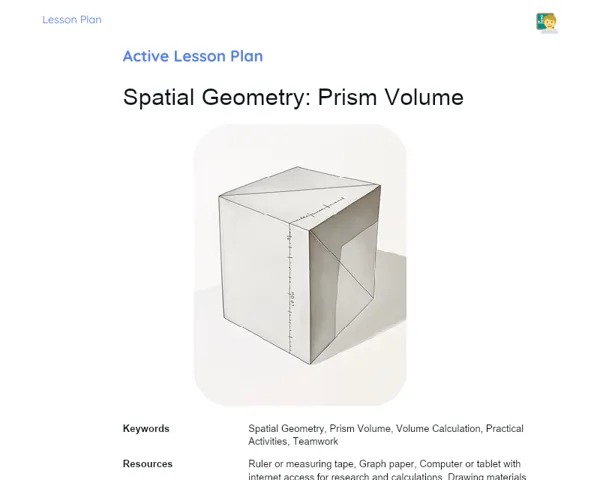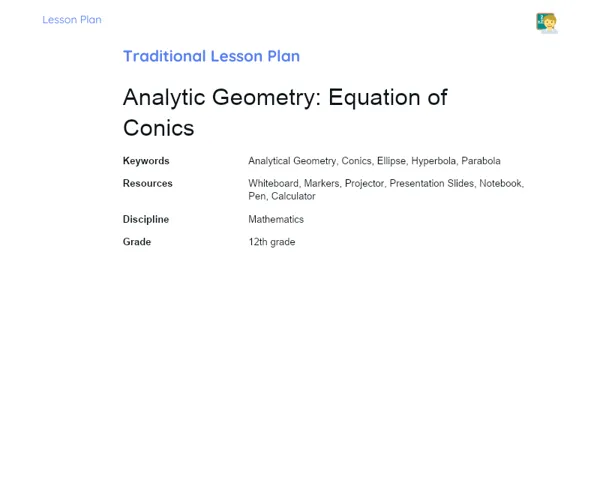Lesson Plan | Lesson Plan Tradisional | Trigonometric Inequality
| Keywords | Trigonometric Inequalities, Sine, Cosine, Tangent, Domain, Intervals, Trigonometric Transformations, Graphical Analysis, Trigonometric Identities, Practical Examples, Problem Solving, Audio Engineering, Modeling Periodic Phenomena |
| Resources | Whiteboard and markers, Projector or screen for presentation, Slides or visual aid materials, Scientific calculators, Notebooks and pens for note-taking, Graphs of trigonometric functions, Printed problem sets |
Objectives
Duration: (10 - 15 minutes)
The aim of this stage is to provide a clear overview of the lesson objectives, setting the stage for what students are about to learn. By outlining these objectives, the teacher establishes a framework that will guide lesson development and help students grasp the significance and applications of trigonometric inequalities.
Objectives Utama:
1. Introduce the concept of trigonometric inequalities, focusing on sine, cosine, and tangent functions.
2. Demonstrate methods for solving trigonometric inequalities with practical and varied examples.
3. Enhance students' problem-solving skills in trigonometric inequalities through guided practice.
Introduction
Duration: (10 - 15 minutes)
🎯 Purpose: The intention of this segment is to pique students' interest and provide context about how trigonometric inequalities apply in real life. By sharing relatable examples and interesting facts, the teacher strengthens the link between mathematical theory and the students' everyday lives, which fosters their engagement with the lesson content.
Did you know?
🔍 Curiosity: Did you know that trigonometric inequalities play a vital role in audio engineering when designing the acoustics of spaces? In places like concert halls and recording studios, engineers rely on these inequalities to ensure sound waves behave in a particular way, ultimately delivering the best sound quality. This goes to show how mathematics can directly influence our experiences and improve our quality of life.
Contextualization
🧮 Context: To kick off the lesson on trigonometric inequalities, highlight how important trigonometric functions are in studying waves and modeling periodic events like tides and radio signals. Stress that grasping trigonometric inequalities is essential for tackling problems regarding limitations and conditions in oscillatory and cyclic systems. By working through these inequalities, students will master mathematical tools that are crucial across various scientific and engineering fields.
Concepts
Duration: (50 - 60 minutes)
🎯 Purpose: This section aims to deepen students' comprehension of trigonometric inequalities and lays a robust foundation for problem-solving. By thoroughly covering each topic and solving real-life examples, the teacher ensures that students comprehend the concepts and techniques required, equipping them to tackle trigonometric inequalities on their own.
Relevant Topics
1. 📐 Definition of Trigonometric Inequalities: Define what trigonometric inequalities entail, emphasizing that they are inequalities that incorporate trigonometric functions like sine, cosine, and tangent. It's vital for students to differentiate between trigonometric equations and inequalities.
2. 📊 Domain and Intervals: Explain the domain of trigonometric functions and how to identify the intervals where the inequalities are valid. Use graphs to showcase the behavior of sine, cosine, and tangent functions across different intervals.
3. 🔄 Trigonometric Transformations: Discuss the basic trigonometric transformations, such as changes in amplitude, period, and phase shift, and how these impact the resolution of inequalities.
4. ✏️ Methods of Resolution: Illustrate techniques for solving trigonometric inequalities, including graphical methods and the application of trigonometric identities. Walk through detailed examples for each method, emphasizing the steps and strategies involved.
5. 📚 Practical Examples: Work through practical examples in class, starting with simpler inequalities and gradually increasing their complexity. Ensure that each step is explained thoroughly, allowing students to take notes.
To Reinforce Learning
1. 1. Solve the inequality ( \sin(x) > \frac{1}{2} ) in the interval ( 0 \leq x \leq 2\pi ).
2. 2. Determine the solution set for the inequality ( \cos(x) \leq -\frac{1}{2} ) within the interval ( 0 \leq x \leq 2\pi ).
3. 3. Solve the inequality ( \tan(x) > 1 ) in the interval ( 0 \leq x < \pi ).
Feedback
Duration: (20 - 25 minutes)
🎯 Purpose: This stage aims to reinforce the knowledge that students have gained throughout the lesson by reviewing and discussing the solutions to the presented trigonometric inequalities. This opportunity allows students to clear up any confusion, reflect on the techniques they used, and verify their answers, thereby enhancing their understanding of the topic.
Diskusi Concepts
1. ✅ Question 1: Solve the inequality ( \sin(x) > \frac{1}{2} ) within the interval ( 0 \leq x \leq 2\pi ). Explanation: To identify the values of ( x ) that satisfy ( \sin(x) > \frac{1}{2} ), we need to find the intervals where the sine function is greater than ( \frac{1}{2} ). We know that ( \sin(x) = \frac{1}{2} ) occurs at ( x = \frac{\pi}{6} ) and ( x = \frac{5\pi}{6} ). Therefore, the values satisfying ( \sin(x) > \frac{1}{2} ) within the specified interval are ( \frac{\pi}{6} < x < \frac{5\pi}{6} ). 2. ✅ Question 2: Determine the solution set for the inequality ( \cos(x) \leq -\frac{1}{2} ) in the interval ( 0 \leq x \leq 2\pi ). Explanation: To resolve ( \cos(x) \leq -\frac{1}{2} ), we first pinpoint the values where ( \cos(x) = -\frac{1}{2} ), which appear at ( x = \frac{2\pi}{3} ) and ( x = \frac{4\pi}{3} ). Hence, the values of ( x ) that satisfy ( \cos(x) \leq -\frac{1}{2} ) lie in the intervals ( \frac{2\pi}{3} \leq x \leq \frac{4\pi}{3} ). 3. ✅ Question 3: Solve the inequality ( \tan(x) > 1 ) in the interval ( 0 \leq x < \pi ). Explanation: The tangent function has a period of ( \pi ), and ( \tan(x) = 1 ) at ( x = \frac{\pi}{4} ). Within the given interval, the solution for ( \tan(x) > 1 ) is ( \frac{\pi}{4} < x < \frac{3\pi}{4} ).
Engaging Students
1. 🤔 Question 1: How do the values of critical points (like ( \frac{\pi}{6} ) and ( \frac{5\pi}{6} ) for sine) inform the solution intervals? 2. 🤔 Question 2: Why is considering the domain of trigonometric functions vital when solving inequalities? 3. 🤔 Question 3: How can trigonometric transformations (like adjustments in amplitude and period) influence how we resolve an inequality? 4. 🤔 Question 4: When working with inequalities involving sine, cosine, and tangent, how might graphs assist in visualizing and confirming your solutions?
Conclusion
Duration: (10 - 15 minutes)
The intention of this stage is to solidify the knowledge that students have gained by summarizing the key points of the lesson and reinforcing the connection between theory and practice. This final recap ensures students have a solid understanding of the content while motivating them by highlighting the practical applications and significance of what they've learned.
Summary
['Defined trigonometric inequalities and clarified the distinction between equations and inequalities.', 'Discussed the domain of trigonometric functions and identified valid intervals for solutions.', 'Explored trigonometric transformations and their impact on resolving inequalities.', 'Outlined methods for solving trigonometric inequalities, including graphical analysis and the use of trigonometric identities.', 'Worked through practical examples progressing from simple to more complex, with thorough explanations.']
Connection
During the lesson, we linked the theory of trigonometric inequalities to practice by solving real-world examples and discussing practical applications, like audio engineering and modeling periodic phenomena. This helped students see how theoretical concepts translate into everyday situations and various professional domains.
Theme Relevance
Trigonometric inequalities are essential in numerous areas, including science and engineering, for predicting tides, designing acoustics, and processing radio signals. Mastering these inequalities equips students with the skills to solve complex problems and comprehend various natural and technological phenomena, showcasing the crucial role of mathematics in enhancing our quality of life.



